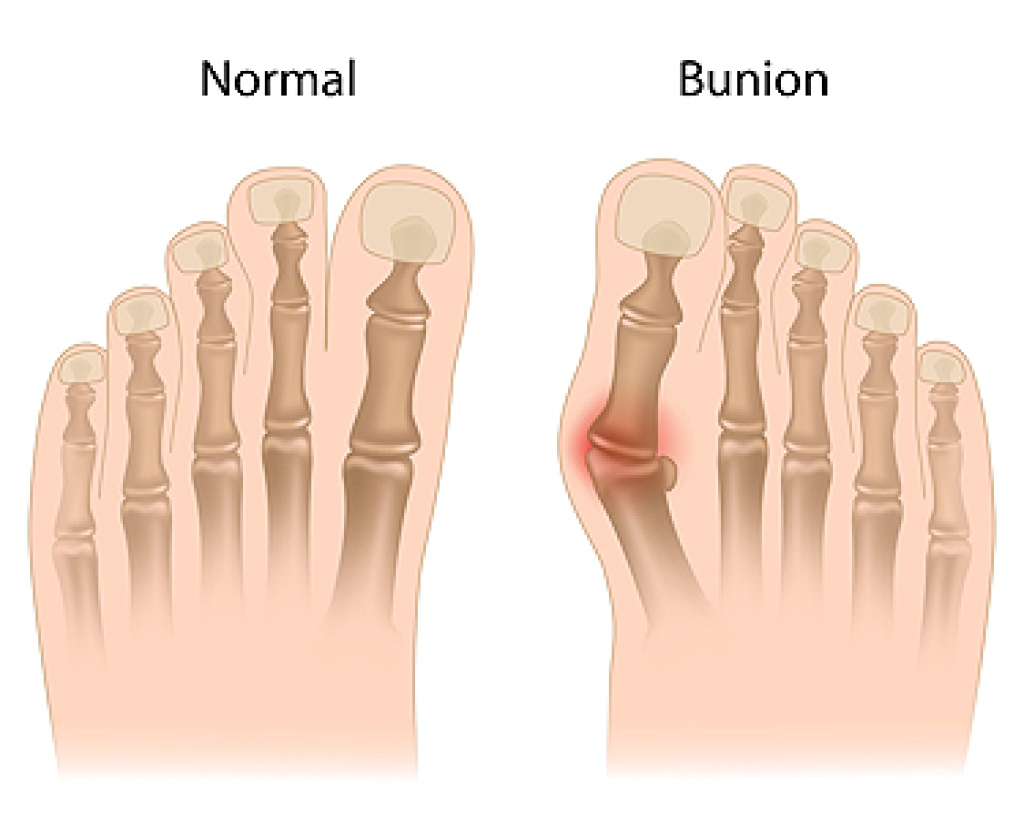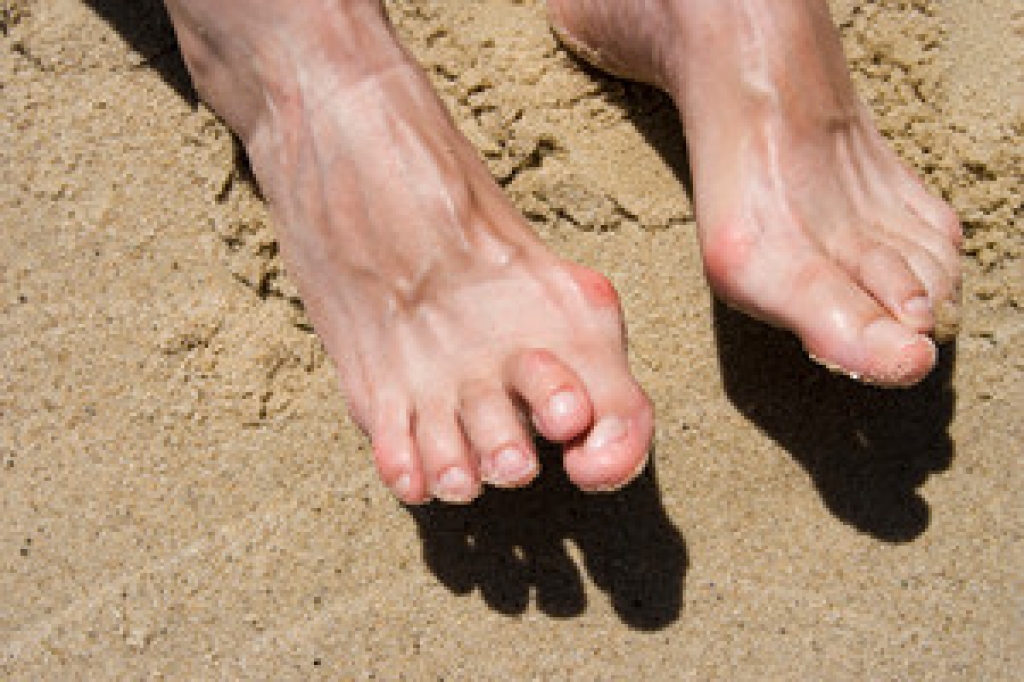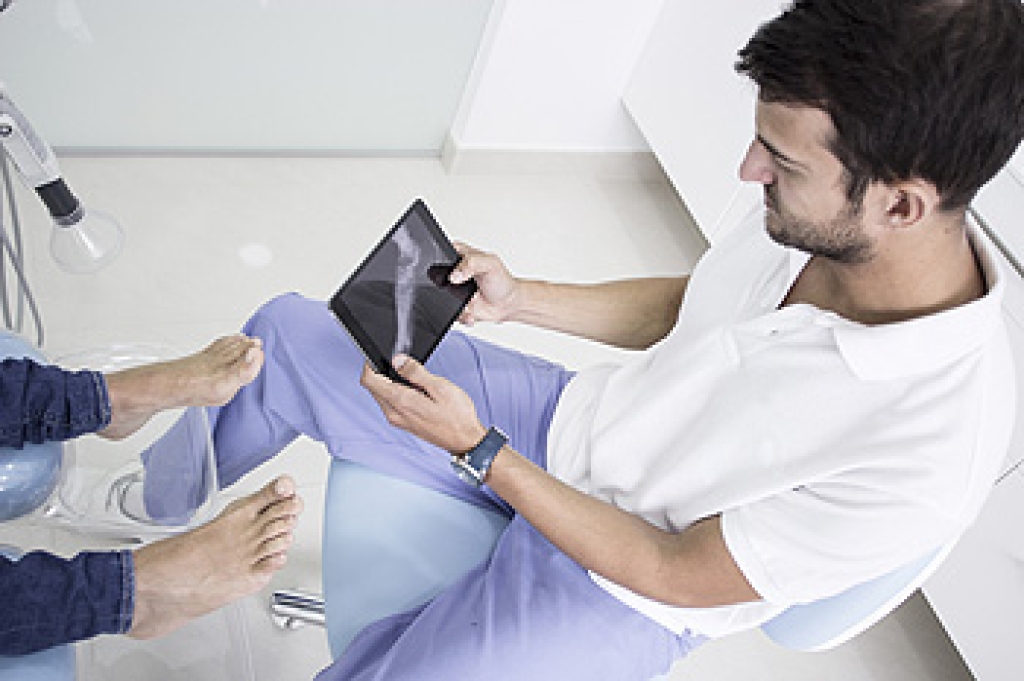Blog
A Bump Can Indicate a Bunion Has Formed
 A noticeable bony bump on the bottom of the big toe may indicate a bunion has developed. If it forms on the pinky toe, it is referred to as a bunionette. A bunion may cause some patients to purchase larger shoes, and it may help to wear a protective covering over it. This ailment is mostly likely caused by wearing shoes that do not have ample room for the toes to move freely in. Additionally, patients who have a genetic history of bunions may be prone to developing them. Mild relief may be found when specific exercises and stretches are frequently performed, and this may help to strengthen the surrounding muscles. Patients whose daily life is negatively affected by bunions are strongly suggested to confer with a podiatrist who can recommend the best treatment methods, which may include surgery for permanent removal.
A noticeable bony bump on the bottom of the big toe may indicate a bunion has developed. If it forms on the pinky toe, it is referred to as a bunionette. A bunion may cause some patients to purchase larger shoes, and it may help to wear a protective covering over it. This ailment is mostly likely caused by wearing shoes that do not have ample room for the toes to move freely in. Additionally, patients who have a genetic history of bunions may be prone to developing them. Mild relief may be found when specific exercises and stretches are frequently performed, and this may help to strengthen the surrounding muscles. Patients whose daily life is negatively affected by bunions are strongly suggested to confer with a podiatrist who can recommend the best treatment methods, which may include surgery for permanent removal.
If you are suffering from bunion pain, contact One of our podiatrist of Santi Podiatry Group. Our doctors can provide the care you need to keep you pain-free and on your feet.
What Is a Bunion?
Bunions are painful bony bumps that usually develop on the inside of the foot at the joint of the big toe. As the deformity increases over time, it may become painful to walk and wear shoes. Women are more likely to exacerbate existing bunions since they often wear tight, narrow shoes that shift their toes together. Bunion pain can be relieved by wearing wider shoes with enough room for the toes.
Causes
- Genetics – some people inherit feet that are more prone to bunion development
- Inflammatory Conditions - rheumatoid arthritis and polio may cause bunion development
Symptoms
- Redness and inflammation
- Pain and tenderness
- Callus or corns on the bump
- Restricted motion in the big toe
In order to diagnose your bunion, your podiatrist may ask about your medical history, symptoms, and general health. Your doctor might also order an x-ray to take a closer look at your feet. Nonsurgical treatment options include orthotics, padding, icing, changes in footwear, and medication. If nonsurgical treatments don’t alleviate your bunion pain, surgery may be necessary.
If you have any questions, please feel free to contact our offices located in on 5th Street and Kings Highway Brooklyn, NY . We offer the newest diagnostic and treatment technologies for all your foot care needs.
What are Signs of Hammertoe?
 Hammertoe is a condition in which the joints of a toe become deformed, causing the toe to bend abnormally downward. This condition generally affects the second toe, but can occur in the third, fourth, or pinky toes. The hammertoe may be flexible or rigid. Signs that indicate you have developed a hammertoe can include pain at the top of the toe due to pressure from your shoes, pain at the base of the toe, corns on top of the toe, redness and swelling, and a decreased range of motion in the affected toe. Treatments depend on the severity of the hammertoe and can include conservative measures, such as wearing specialized foot pads or shoe inserts. In more severe cases surgery may be necessary. If you suspect that you have a hammertoe, it is recommended that you visit a podiatrist for proper care and treatment.
Hammertoe is a condition in which the joints of a toe become deformed, causing the toe to bend abnormally downward. This condition generally affects the second toe, but can occur in the third, fourth, or pinky toes. The hammertoe may be flexible or rigid. Signs that indicate you have developed a hammertoe can include pain at the top of the toe due to pressure from your shoes, pain at the base of the toe, corns on top of the toe, redness and swelling, and a decreased range of motion in the affected toe. Treatments depend on the severity of the hammertoe and can include conservative measures, such as wearing specialized foot pads or shoe inserts. In more severe cases surgery may be necessary. If you suspect that you have a hammertoe, it is recommended that you visit a podiatrist for proper care and treatment.
Hammertoes can be a painful condition to live with. For more information, contact One of our podiatrist of Santi Podiatry Group. Our doctors will answer any of your foot- and ankle-related questions.
Hammertoe
Hammertoe is a foot deformity that occurs due to an imbalance in the muscles, tendons, or ligaments that normally hold the toe straight. It can be caused by the type of shoes you wear, your foot structure, trauma, and certain disease processes.
Symptoms
- Painful and/or difficult toe movement
- Swelling
- Joint stiffness
- Calluses/Corns
- Physical deformity
Risk Factors
- Age – The risk of hammertoe increases with age
- Sex – Women are more likely to have hammertoe compared to men
- Toe Length – You are more likely to develop hammertoe if your second toe is longer than your big toe
- Certain Diseases – Arthritis and diabetes may make you more likely to develop hammertoe
Treatment
If you have hammertoe, you should change into a more comfortable shoe that provides enough room for your toes. Exercises such as picking up marbles may strengthen and stretch your toe muscles. Nevertheless, it is important to seek assistance from a podiatrist in order to determine the severity of your hammertoe and see which treatment option will work best for you.
If you have any questions, please feel free to contact our offices located in on 5th Street and Kings Highway Brooklyn, NY . We offer the newest diagnostic and treatment technologies for all your foot care needs.
Achilles Tendonitis in Ballet Dancers

Achilles tendonitis is inflammation of the tendon that connects the calf muscles to the heel bone, often caused by overuse or repetitive strain. Symptoms include pain along the back of the heel, swelling, stiffness, and discomfort that worsens with activity. Ballet dancers are especially prone to this condition because of constant jumping, pointing of the toes, and dancing on the balls of the feet, all of which place intense stress on the Achilles tendon. Without treatment, the tendon can weaken and risk further injury. A podiatrist can help by diagnosing the condition, recommending rest, stretching, and supportive footwear. If you have heel pain or stiffness, it is suggested that you consult a podiatrist who can offer appropriate treatment and relief solutions for what might be going on.
Achilles tendon injuries need immediate attention to avoid future complications. If you have any concerns, contact One of our podiatrist of Santi Podiatry Group. Our doctors can provide the care you need to keep you pain-free and on your feet.
What Is the Achilles Tendon?
The Achilles tendon is a tendon that connects the lower leg muscles and calf to the heel of the foot. It is the strongest tendon in the human body and is essential for making movement possible. Because this tendon is such an integral part of the body, any injuries to it can create immense difficulties and should immediately be presented to a doctor.
What Are the Symptoms of an Achilles Tendon Injury?
There are various types of injuries that can affect the Achilles tendon. The two most common injuries are Achilles tendinitis and ruptures of the tendon.
Achilles Tendinitis Symptoms
- Inflammation
- Dull to severe pain
- Increased blood flow to the tendon
- Thickening of the tendon
Rupture Symptoms
- Extreme pain and swelling in the foot
- Total immobility
Treatment and Prevention
Achilles tendon injuries are diagnosed by a thorough physical evaluation, which can include an MRI. Treatment involves rest, physical therapy, and in some cases, surgery. However, various preventative measures can be taken to avoid these injuries, such as:
- Thorough stretching of the tendon before and after exercise
- Strengthening exercises like calf raises, squats, leg curls, leg extensions, leg raises, lunges, and leg presses
If you have any questions please feel free to contact our offices located in on 5th Street and Kings Highway Brooklyn, NY . We offer the newest diagnostic tools and technology to treat your foot and ankle needs.
The Work of a Podiatrist

A podiatrist is a medical specialist who focuses on the health of the feet and ankles. Their training prepares them to diagnose and treat a wide range of conditions, from everyday issues like ingrown toenails and calluses to more complex problems such as fractures, tendon injuries, and diabetic foot complications. Podiatrists also play a vital role in identifying circulation problems, nerve damage, and structural changes that may affect walking and balance. Treatments can include custom orthotics, wound care, and surgical procedures, when needed. Beyond addressing pain and injury, podiatrists work to prevent long-term complications by monitoring changes in the feet that might signal larger health concerns. This combination of medical knowledge and hands-on care allows patients to maintain mobility and independence. For concerns related to foot or ankle health, or if you are interested in pursuing podiatry as a career choice, it is suggested that you see a podiatrist.
If you are experiencing pain in the feet or ankles, don’t join the stubborn majority refusing treatment. Feel free to contact One of our podiatrist from Santi Podiatry Group. Our doctors can provide the care you need to keep you pain-free and on your feet.
What Is a Podiatrist?
Someone would seek the care of a podiatrist if they have suffered a foot injury or have common foot ailments such as heal spurs, bunions, arch problems, deformities, ingrown toenails, corns, foot and ankle problems, etc.
Podiatric Treatment
A podiatrist will treat the problematic areas of the feet, ankle or lower leg by prescribing the following:
- Physical therapy
- Drugs
- Orthotic inserts or soles
- Surgery on lower extremity fractures
A common podiatric procedure a podiatrist will use is a scanner or force plate which will allow the podiatrist to know the designs of orthotics. Patients are then told to follow a series of tasks to complete the treatment. The computer will scan the foot a see which areas show weight distribution and pressure points. The podiatrist will read the analysis and then determine which treatment plans are available.
If you have any questions, please feel free to contact our offices located in on 5th Street and Kings Highway Brooklyn, NY . We offer the newest diagnostic and treatment technologies for all your foot care needs.


